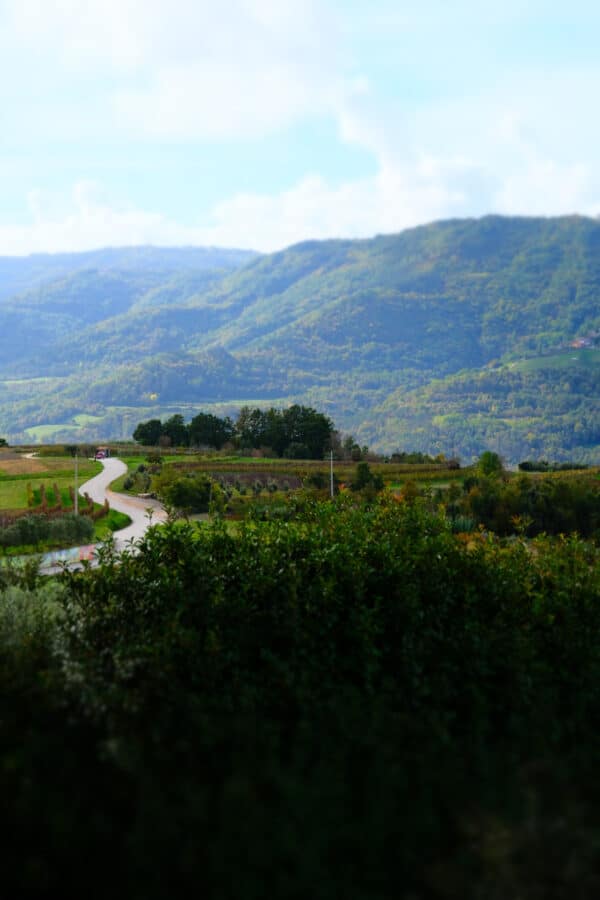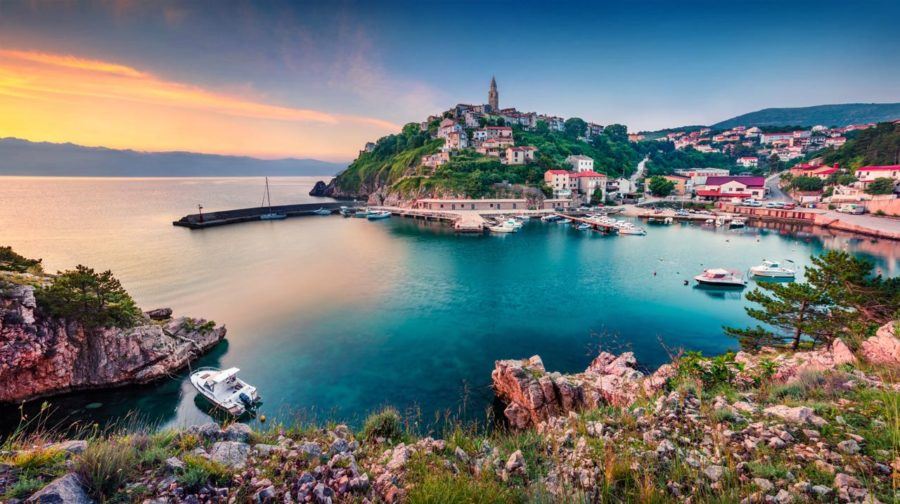Alright, let’s dive into what you need to know about driving along the coast of Croatia during the summer. These are my best tips after driving in Croatia for the last 15 summers (and living here!).

Skip Ahead To My Advice Here!
Driving Tip In Croatia: Navigating The Roads
The weather is warm, the roads are calling, and the Adriatic is right beside you. But before you hit the road, let’s go over a few important details to ensure your coastal road trip is as smooth as possible.
1. Understanding Roads In Croatia And Traffic Conditions

First off, let’s talk road conditions. The main highways, particularly the A1, are well-maintained, making for an easy drive. However, once you start exploring the smaller coastal towns or heading up into the hills, expect narrower, winding roads that require more attention.
These roads often come with sharp turns and may lack proper shoulders, so drive cautiously, especially when locals take those turns like they’re on a racetrack. Parking can also be a challenge in these charming towns—spaces are tight, and the streets even tighter.
During the summer, traffic along the coast can be heavy. With everyone heading to the beach, expect delays. To avoid the worst of it, consider driving early in the morning or later in the afternoon when the roads are less crowded and temperatures have cooled a bit.
2. Parking In Croatia: Tips For The Big Cities And Coastal Towns

Parking in popular coastal areas can be tricky. In the busiest spots, finding a parking space might feel like winning a small lottery. When you do find a spot, it’s likely to be a tight fit, so a smaller car is definitely advantageous.
If you’re bringing a larger vehicle, be prepared for some challenges—both in finding a space and in maneuvering into it. Also, remember that most parking isn’t free so keep some euros handy for meters or use your phone to text to pay to make life easier. If parking is too much of a hassle, public transport within cities can be a stress-free alternative.
3. Driving In Cities In Croatia: What To Expect

Croatian drivers are known for their assertiveness. While the general attitude in daily life might be relaxed, that calm demeanor doesn’t always extend to the road.
Overtaking is common, sometimes in places that might make you raise an eyebrow. The best approach is to stay calm, drive defensively, and let faster drivers pass—they’re likely in a hurry to get to the next beach.
4. Choosing Between Manual and Automatic Cars In Croatia: Car Rental Tips
When renting a car, you’ll notice that automatics are significantly more expensive than manuals. If you’re comfortable driving a stick shift, it’s a great way to save money. Plus, smaller manual cars are easier to navigate on narrow roads and in tight parking spots.
Keep in mind that these cars usually have smaller trunks, so pack accordingly.
5. Speeding Fines, Toll Roads, And Highways: Essential Information

Here’s a useful tip: if you get pulled over for speeding, you might be offered a discount if you pay the fine on the spot. It’s totally legit to receive a 50% reduction for immediate payment, so keeping some cash on hand might save you some money.
Also, be aware of toll roads on Croatia’s highways, particularly when driving between major cities like Zagreb and Dubrovnik. Remember to pay at the exit.
6. Summer Hazards On Croatian Roads: Heat, Tourists, And More
Summer in Croatia can get quite hot, so keep an eye on your tire pressure as the heat can affect it. Always carry plenty of water—for both you and the car. Be on the lookout for unexpected obstacles, like tourists wandering into the road, children chasing after an ice cream truck, or even a goat crossing your path. It’s all part of the experience.
7. Scenic Routes And Safe Driving In Croatia: Enjoy Croatia’s Views

The coastal views are spectacular, and you’ll definitely want to capture them. However, don’t stop in the middle of the road to take photos. There are plenty of designated pull-over spots where you can safely enjoy the scenery without causing a traffic jam.
8. Gas Stations And Petrol Stations In Croatia: Filling Up Your Tank
Fuel stations are easy to find on main roads, but if you’re planning to explore more remote areas, it’s a good idea to top off your tank whenever you can. The last thing you want is to be stranded in the middle of nowhere with an empty tank.
9. Winter Vs. Summer Driving In Croatia: What You Need To Know

Driving in winter is a completely different experience. Roads, especially in the mountains, can be icy, and snow chains or winter tires might be necessary. In contrast, summer driving is all about managing heat and tourist crowds, each with its own set of challenges.
Brands We Use And Trust
Driving Rules And Regulations
General Requirements
Driver’s License
A valid driver’s license from your home country is required. If your license is not in the Latin alphabet, an international driver’s license is necessary.
Documents
Keep your passport or ID easily accessible, as you may need to present it if requested by authorities.
Driving Rules
Driving Side
Drive on the right-hand side of the road.
Speed Limits
Motorways: 130 km/h
Open roads: 90 km/h
Urban areas: 50 km/h
Some road segments may have different limits; always follow road signs.
Headlights
Required during the day from November 1st to March 31st.
Winter Tires
Mandatory from November 15th to April 15th on winter road sections. It is not required in the Istria and Dalmatia regions.
Seatbelts
It is mandatory for all passengers, including those in the backseat.
Child Safety
Child seats are required for children under 135 cm in height, but children over 150 cm can sit in the front seat.
Overtaking
Allowed on a hatched line. Prohibited on a solid line.
Mobile Phones
Using a mobile phone while driving is prohibited unless using hands-free devices.
Right-of-Way
In the absence of other rules, vehicles on your right have the right-of-way.
Alcohol Limits
The legal blood alcohol limit is 0.05%, but zero tolerance applies if you are involved in an accident. It’s important to note that for professional drivers and drivers under the age of 24, the limit is 0.00%.
Safety and Conditions
Road Conditions
Generally well-maintained and smooth, though some island and countryside roads may be narrow and lack protective barriers.
Driving in Cities
Traffic can be heavy, especially in big cities like Zagreb, Split, and Rijeka. Public transportation is recommended within cities.
Driving in the Countryside
Be cautious of wild animals, farm vehicles, and cyclists, particularly on narrow roads.
Toll Roads
Tolls are charged on most multi-lane motorways. Tolls can be paid in cash, by credit card, or by using an ENC device (electronic toll collection).
Highways and Tolls
Traffic Congestion
Roads are especially crowded during the summer and on weekends. To avoid traffic jams, consider using local roads or “bra cesta” (fast roads without tolls).
Toll Payment
Short highway sections and specific road objects (tunnels, bridges) require immediate toll payment. On longer highways, collect a toll card at the entrance and pay at the exit.
ENC Devices
A prepaid device for contactless toll payment, ideal for frequent highway users. It is topped up via authorized sales points, internet banking, or the HAC ENC mobile app.
Toll Exemptions
Certain groups, including people with severe physical impairments and Croatian Disabled Homeland War Veterans, are exempt from paying tolls.
Finding Gas Stations
Total Petrol Stations
Approximately 918 stations across Croatia, including 74 stations along highways.
Highway Stations
Typically equipped with stores, bars, restrooms, and restaurants.
Regular Road Stations
They usually have stores and sometimes a bar, so they are less likely to have restaurants. Expect higher prices at gas station stores compared to regular supermarkets.
Parking in Croatia
Major Cities
Finding parking in cities like Zagreb, Split, and Rijeka can be challenging and expensive, especially during the summer.
City Centers
Avoid parking in city centers due to high costs and limited availability. If allowed, consider parking in residential areas.
Parking Fines
Improper parking can result in fines or your car being towed (referred to as the “pauk” or spider).
Parking Machines
Multilingual machines are available; payment can be made with cash or credit card.
Mobile Parking Apps
Bmove App: Allows payment for parking in over 90 Croatian cities.
SMS Payment: This option is available with Croatian mobile numbers; you can pay by texting your license plate number to a specific code.
Underground Garages
This is a good option in cities to protect your car and keep it safe; it is available in cities like Zagreb, Rijeka, and Dubrovnik.
Car Washing in Croatia
Types of Car Washes
Self-Service: Inexpensive and quick, suitable for light cleaning.
Automatic Car Wash: More detailed and faster; includes multiple cleaning steps.
Private Car Wash: Most thorough, but also the most time-consuming and expensive.
Costs
Self-Service: €1.40 – €2.50
Automatic: €3.35 – €6
Private: Up to €20
Electric Charging Stations
There are approximately 700 public stations available, typically located in parking lots, gas stations, shopping centers, hotels, and restaurants. But, while Electric vehicle (EV) charging stations are expanding rapidly they are still less common in very remote or island areas.
Croatian Road Trip Vocabulary
Autocesta – Highway
Cestarina – Toll
Parkiralište – Parking
Benzinska postaja – Gas station
Vinjetta – Vignette (required for driving in Slovenia and Hungary)
Brza cesta – Fast road
Pauk – Vehicle tow (spider)
Top Croatia Road Trip Itinerary Ideas
1. Dalmatian Coast: Split To Dubrovnik

One of the most iconic road trips in Croatia is the drive from Split to Dubrovnik along the Dalmatian Coast. This route offers breathtaking views of the Adriatic Sea, charming coastal towns, and historical sites.
Key stops include the ancient city of Trogir, the picturesque town of Makarska, and the stunning beaches of the Pelješac Peninsula. Don’t miss the chance to take a detour to the beautiful island of Hvar, known for its lavender fields and vibrant nightlife.
The trip culminates in Dubrovnik, a UNESCO World Heritage site famous for its medieval walls and stunning architecture.
2. Istrian Peninsula: Rovinj To Pula Via Plitvice Lakes

For a blend of natural beauty and rich history, the Istrian Peninsula is a must. Start in the enchanting town of Rovinj, with its narrow streets and colorful buildings, and head south towards Pula.
Along the way, explore the Lim Fjord, known for its stunning scenery and seafood, and the hilltop town of Motovun, famous for its truffles and medieval charm. The route ends in Pula, home to one of the best-preserved Roman amphitheaters in the world. Consider a detour to Plitvice Lakes for an unforgettable experience of Croatia’s natural beauty.
This road trip is perfect for foodies, history buffs, and anyone looking to experience the diverse culture of Croatia.
3. Kvarner Gulf: Rijeka To Zadar Via Krka National Park

This lesser-known route offers a mix of coastal beauty and mountainous landscapes. Start in Rijeka, Croatia’s third-largest city, and head south along the coast of the Kvarner Gulf.
The drive offers stunning views of the Adriatic Sea, with opportunities to visit the islands of Krk and Rab. Continue to the coastal town of Senj, known for its medieval fortress, and then make your way to Zadar. Consider visiting Krka National Park along the way to witness its stunning waterfalls.
Zadar is famous for its Roman and Venetian ruins, as well as its unique Sea Organ, an architectural sound art installation. This route is ideal for those seeking a quieter, off-the-beaten-path adventure.
Move This Adventure To Your Inbox & Get An Instant Freebie

No spam. Unsubscribe at any time.
Wrap Up On Summer Driving In Croatia
With these tips in mind, you’re all set for an enjoyable road trip in Croatia. Whether you’re exploring the cities, navigating the countryside, or planning to leave Croatia for neighboring countries, take your time, enjoy the ride, and don’t sweat the small stuff. You’re driving through one of the most beautiful regions in the world—make the most of it.
- Ultimate Guide To Accommodation In Croatia
- Croatia Airport Transfers
- Weird, Interesting & Unique Things To Do In Croatia
- Explore Croatia In Winter
- Croatian Wine You Can’t-Miss
- Croatia Road Trip Itinerary
- Game Of Thrones Locations & Tours In Croatia
- Best Day Trips From Dubrovnik
- Places, Cities, And Towns In Croatia To Explore
- Car Free Islands In Croatia
- What You Need To Know For Planning A Trip To Croatia
- Things To Know Before Visiting Dubrovnik
- Is Croatia Safe To Travel? Helpful Safety Tips
- When Is The Best Time To Visit Croatia

